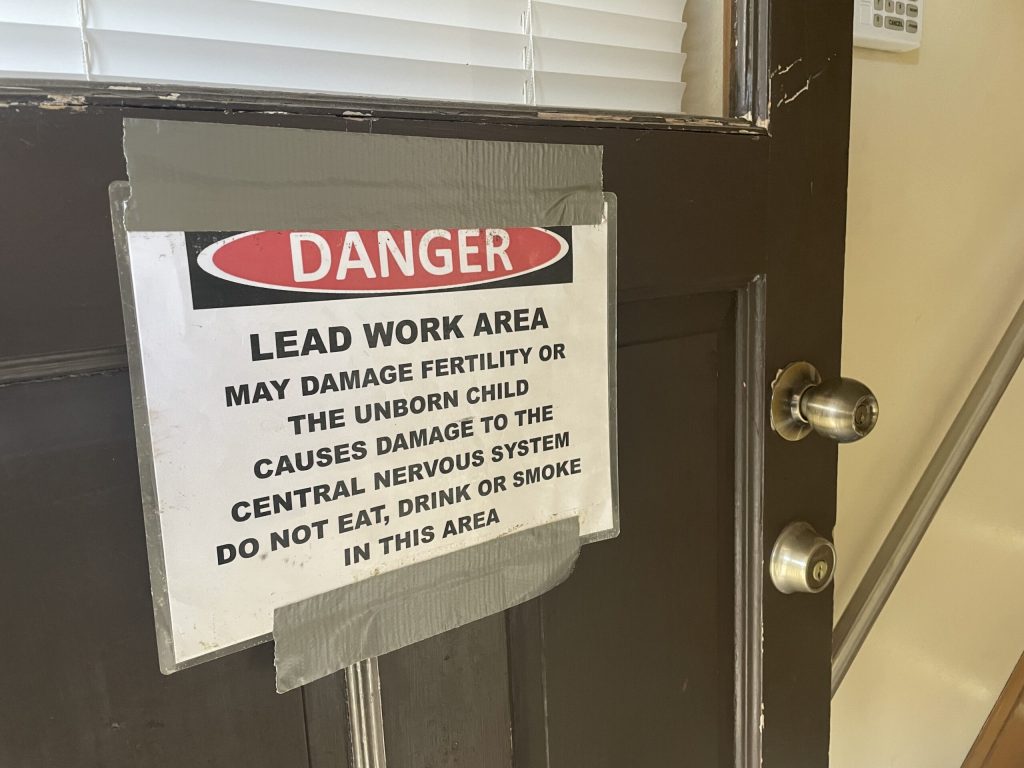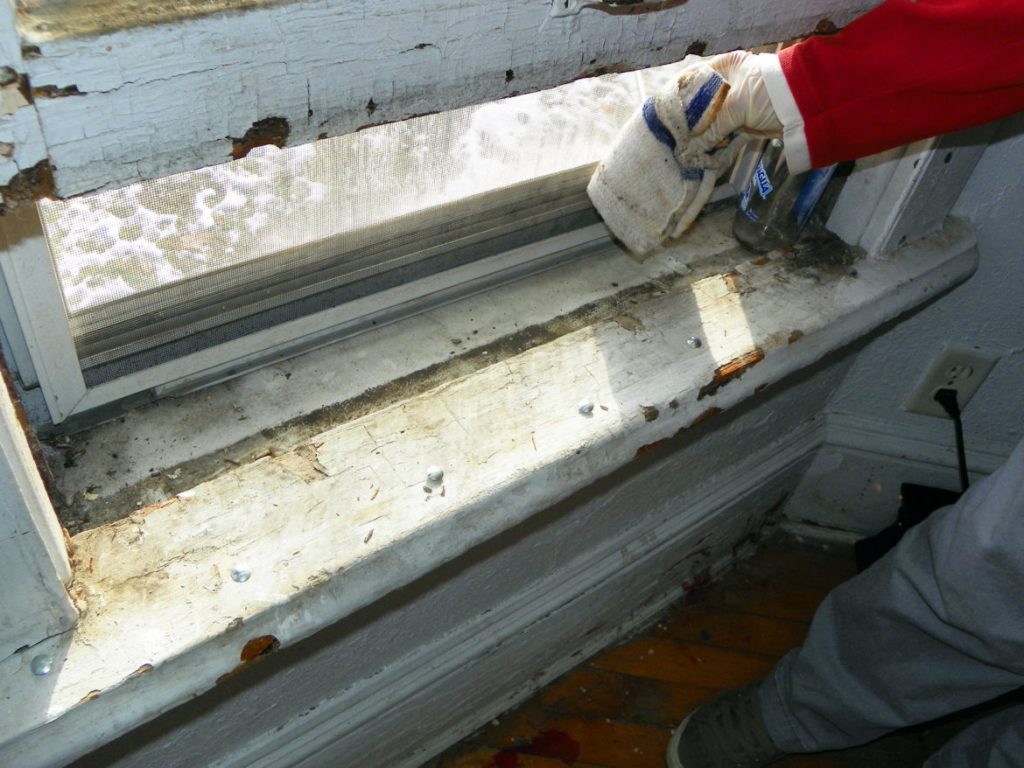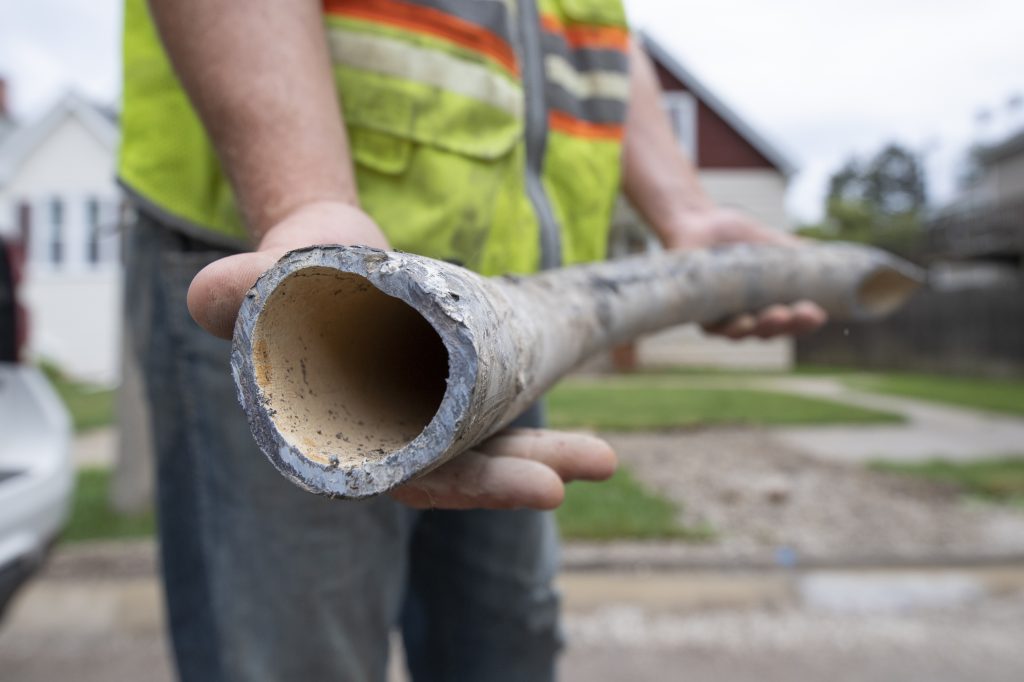What To Know and How To Keep Kids Safe From Lead Poisoning
More than 4,500 children under age 6 tested positive for lead poisoning in Wisconsin last year. It has no overt symptoms.

A sign on the back door of a house on Milwaukee’s North Side warns of lead abatement work on Oct. 23, 2024. Nick Rommel/WPR
The Milwaukee Public Schools district has been dealing with a lead crisis for months.
Lead hazards have been found in seven schools in Milwaukee so far, and four MPS students have tested positive for lead poisoning.
No amount of lead in the blood is safe for children, according to the U.S. Centers for Disease Control and Prevention. The CDC has found that children under the age of 6 are the most at risk.
Last year, more than 4,500 children under the age of 6 tested positive for lead poisoning in Wisconsin, according to Brian Weaver, the lead policy advisor with the Wisconsin Department of Health Services.
“It is a statewide issue in Wisconsin,” Weaver said. “We see lead poisoning cases across the state and in most counties.”
More than 2,000 children test positive for lead poisoning every year in the city of Milwaukee, said Tyler Weber, deputy commissioner of the Milwaukee Health Department’s environmental health division.
Public health experts say getting children tested for lead is crucial.
“We still have children every day who are becoming lead poisoned because of unsafe environments, and the only way that parents are going to know is by having their child tested,” said Dr. Heather Paradis, the medical director and the head of the Children’s Wisconsin lead program.
Data from the Wisconsin Department of Health Services found about 75,000 children got a blood lead test in 2023. That’s down from about 100,000 children who were tested each year in Wisconsin from 2009 to 2011, according to the department.
Beginning in 2024, the state recommended blood lead testing for:
- All children — once at the age of 1 and once at the age of 2.
- Any child ages 3 to 5 who has not been tested previously.

Lead poisoning of children has largely been tied to contact with old, peeling paint. Here, a Milwaukee, Wis. rental home is investigated for lead in a 2015 inspection. Matt Campbell/Wisconsin Watch
What is lead and where is it found?
Lead is a heavy metal that can be toxic to humans and animals. It can be found in the air, soil, water, paint and even in some products.
“Lead is a soft, gray metal that’s found in nature, but it’s toxic when it enters into the body through eating, drinking, touching or breathing lead-contaminated items,” said Holly Nannis, the public health nurse supervisor in the childhood lead program with the Milwaukee Health Department.
Nannis said children might play with paint chips if they’re on the floor or on a windowsill. They could also breathe in lead dust.
“And it’s right at the height where children can breathe it in, or they will play with paint chips, and then things go into their mouth,” Nannis said.
Soil can be contaminated with lead, too.
“Deposits from leaded gasoline, exterior lead-based paint, and industrial sources have contributed to increased levels of lead in the soil,” according to the CDC. “This is especially common in urban areas and homes built before 1978.”
Nannis said lead in the soil can be a problem when kids play outside.
“If they’re playing in dirt, which kids do, and then they don’t wash their hands or stuff goes into their mouth, that’s another way for kids to be exposed to lead,” Nannis said.
Lead can be found in drinking water, as lead was used to coat the inside of older water pipes.
“Certain pipes that carry drinking water from the water source to the home may contain lead,” according to the CDC. “Household plumbing fixtures, welding solder, and pipe fittings made prior to 1986 may also contain lead.”
Lead can even be found in the air.
“At the national level, major sources of lead in the air are ore and metals processing and piston-engine aircraft operating on leaded aviation fuel,” according to the U.S. Environmental Protection Agency. “Other sources are waste incinerators, utilities, and lead-acid battery manufacturers. The highest air concentrations of lead are usually found near lead smelters.”
Lead can also be found in some imported products to the United States:
- You can learn more about lead in foods and medicines on the CDC website here.
- You can learn more about lead in toys and jewelry on the CDC website here.
What is a positive lead poisoning case and who is most at risk?
A blood lead level is measured in micrograms of lead per deciliter of blood. Positive lead poisoning is when someone tests at or above 3.5 micrograms per deciliter.
“When it [lead] enters the body, it circulates throughout the blood, and it then causes damage to developing brains, nervous systems,” Nannis said.
Nannis said young children and toddlers are most at risk for lead poisoning because of their hand-to-mouth behavior.
“They explore their world by putting everything in their mouth,” Nannis said.
Lead poisoning often has no “overt symptoms,” Paradis said.
“So, parents wouldn’t otherwise know that their child has been exposed to lead, unless we do a test,” Paradis said.
Adults who perform home renovations or work in vehicle repair shops could also be exposed to lead.
Lead in the bones of adults could be released into the bloodstream during a pregnancy, exposing a baby to lead, according to the CDC.
How can you get tested and what do the tests involve?
There are two types of blood lead tests — a capillary sample and a venous sample.
A capillary sample is a finger-prick test that’s used to take a small amount of blood. Those samples are usually collected first because it’s a simpler test.
“Everything starts out with a capillary because it’s less invasive, and it’s a way to screen out kids that really are at lower risk,” Nannis said.
Nannis said if a child tests at or above 3.5 micrograms per deciliter with a capillary sample, a venous sample is ordered.
“And the reason we recommend a venous test gets done is that there is room for error with the finger poke [Capillary sample],” Nannis said.
A venous sample is when a needle is inserted into a vein. It can take a few days to get the results of that test.
Nannis said health insurance plans and Medicaid cover blood lead testing. She said “routine testing” with a child’s primary care doctor is crucial.
“Get your kids in. Get them tested, and get them tested routinely,” Nannis said.

Tom Iglinski, an engineering technician with the city of Milwaukee, holds up a replaced lead service line on June 29, 2021. Isaac Wasserman/Wisconsin Watch
What happens after a positive case?
Local health departments in Wisconsin get notified when a child tests positive for lead poisoning. Paradis said the child’s primary care doctor will get involved when a child tests positive from 3.5 to 14.9 micrograms per deciliter.
In Wisconsin, the local health department will get involved if a child tests positive twice at 15 micrograms per deciliter or above at least 90 days apart, or above 20 micrograms per deciliter once. That child and family will get a nurse case manager and an inspector.
The inspector will check for any lead hazards in the home. They could test the soil and look for other hazards inside and outside of the home, Nannis said.
“But the No. 1 culprit usually always comes back to the paint,” she said.
A child who tests at or above 45 micrograms per deciliter will receive medication that can help remove the lead at a faster rate.
How to keep your home and child safe
Weaver said homes built before 1978 where the paint has not been maintained can be hazardous to children. He said a certified lead inspector should check the property for any lead hazards if there are signs of wear in a home — like chipping or peeling paint around windows or door frames.
“We would also recommend if they’re actually going to fix any lead paint or move any lead paint in the home that they hire a certified lead contractor because they have been trained to do it properly,” Weaver said.
The Wisconsin Lead-Safe Homes Program funds lead abatement work for properties built before 1978.
“We have prioritized properties where there are lead poisoned children, and so the Lead-Safe Homes Program is able to work with local partners to remediate and abate the lead paint hazards in those homes,” Weaver said.
For families who live in older homes, Nannis said those children should wash their hands often. When they’re playing outside, children should take their shoes off before they come inside.
“A lot of lead in the dirt can be tracked into people’s houses,” Nannis said.
Nannis also said wet washing floors and window sills can also be helpful.
To reduce exposure to lead dust in an older home, the EPA said it’s important to “maintain all painted surfaces in good condition.”
“Inspect and keep all painted surfaces in excellent shape and clean up dust frequently with a wet cloth or paper towel,” according to the EPA.
Weaver said individuals can contact their water provider in a municipality to see if their home has a lead service line connected to their home. If families are concerned about drinking water, there are certified water filters that can help eliminate lead.
Cities across the state have been working to replace lead pipes for years.
For questions: Contact the Wisconsin Lead-Safe Homes Program at 608-267-9191 or by email at DHSLeadSafe@dhs.wisconsin.gov.
Lead poisoning in Milwaukee Public Schools: What to know and how to keep your kids safe was originally published by Wisconsin Public Radio.
If you think stories like this are important, become a member of Urban Milwaukee and help support real, independent journalism. Plus you get some cool added benefits.
More about the Lead Crisis
- $43 Million Later, MPS Says Classrooms Are Safe From Lead Dust - Corrinne Hess - Dec 18th, 2025
- MPS Buildings Cleared of Lead-Paint Risks after 10-Plus Months of Work - Milwaukee Public Schools - Dec 17th, 2025
- Wisconsin Moves to Require Lead Service Lines Replaced By 2037 - Danielle Kaeding - Dec 11th, 2025
- Gov. Evers, DNR Announce More Than $159 Million to Ensure Clean, Safe Drinking Water for Wisconsinites in 29 Municipalities - Gov. Tony Evers - Dec 10th, 2025
- EPA Announces $3 Billion in New Funding for States to Reduce Lead in Drinking Water - U.S. Environmental Protection Agency - Nov 25th, 2025
- Wisconsin Communities Get $282 Million for Drinking Water Projects - Danielle Kaeding - Nov 19th, 2025
- MKE County: County Launches Lead Abatement Program - Graham Kilmer - Nov 9th, 2025
- Milwaukee County Launches Lead Remediation Program to Reduce Lead-Based Paint Hazards in Homes in Suburban Communities - David Crowley - Nov 5th, 2025
- Wisconsin Improves Child Lead Testing Rates, Urges Continued Testing and At-Home Prevention - Wisconsin Department of Health Services - Oct 21st, 2025
- City Hall: Milwaukee Must Replace 100 Lead Laterals Per Week To Meet 2025 Goal - Jeramey Jannene - Oct 1st, 2025
Read more about Lead Crisis here





















